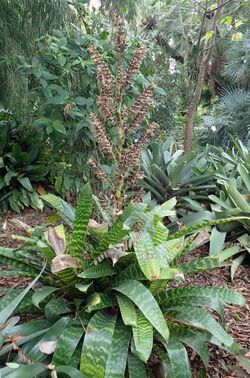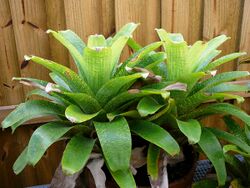Biology:Vriesea hieroglyphica
| Vriesea hieroglyphica | |
|---|---|

| |
| Scientific classification | |
| Kingdom: | Plantae |
| Clade: | Tracheophytes |
| Clade: | Angiosperms |
| Clade: | Monocots |
| Clade: | Commelinids |
| Order: | Poales |
| Family: | Bromeliaceae |
| Genus: | Vriesea |
| Species: | V. hieroglyphica
|
| Binomial name | |
| Vriesea hieroglyphica (Carrière) É.Morren
| |
Vriesea hieroglyphica is a plant species in the genus Vriesea.
The name refers to the linear horizontal patterns on the leaves that resemble hieroglyphs. It has been nicknamed "King of the bromeliads."[1]
Distribution
This bromeliad species is endemic to southeastern Brazil .
It grows at low altitudes in humid conditions under the shade of trees in the Atlantic Forest biome (Mata Atlantica Brasileira).[2]
Description
Vriesea hieroglyphica develops green leaves with irregular dark cross banding and recurved tips. The plant develops 30-40 shiny, bright green leaves measuring 3 feet (0.91 m) long and 3 inches wide.
It typically blooms in spring, and can bloom repeatedly in cultivation, with branching yellow, cream, or white flowers on a tall branched spike. The tall, light green flower spike "bears a branched inflorescence with 1-inch-long, pale green bracts and dull yellow-petaled flowers." [3]
The variety Vriesea hieroglyphica var. Marginata has broad cream−ivory colored bands on the leaves.
Cultivation
The distinctive leaf markings make Vriesea hieroglyphica a popular ornamental plant cultivated for gardening and commercial floristry uses, including as an interior landscape−house plants, potted outdoor plants, and planted in gardens in suitable climates.[4]
Outdoors it can be grown from light to full shade, and is rated for USDA Zone 10 (min 30 °F) and up. Indoors, it is usually grown with a northern exposure and assured humidity.[5]
Cultivars and hybrids


Garden cultivars of Vriesea hieroglyphica, and hybrids with other Vriesea species, include:[6]
- Vriesea 'After Glow'
- Vriesea 'El Supremo'
- Vriesea 'Elvira'
- Vriesea 'Gigant Jade'
- Vriesea 'Glossy Girl'
- Vriesea 'Grand Purple'
- Vriesea 'Hawaiian Sunrise'
- Vriesea 'Intermedia'
- Vriesea 'Jungle Jade'
- Vriesea 'Leverett's Delight'
- Vriesea 'Machu Picchu'
- Vriesea 'Madame Morobe'
- Vriesea 'Maureen'
- Vriesea 'Montezuma's Gem'
- Vriesea 'Pamela Leaver'
- Vriesea 'Patrice'
- Vriesea 'Shizuko Murakami'
- Vriesea 'Yellow Wave'
- Vriesea 'You Beaut'
References
- ↑ Padilla, Victoria (1973). Bromeliads. New York: Crown Publishers. pp. 104. ISBN 0517562413. https://archive.org/details/bromeliads00vict/page/104.
- ↑ Martinelli, Gustavo; Vieira, Cláudia Magalhães; Gonzalez, Marcos; Leitman, Paula; Piratininga, Andréa; Costa, Andrea Ferreira da; Forzza, Rafaela Campostrini (January 2008). "Bromeliaceae da Mata Atlântica Brasileira: lista de espécies, distribuição e conservação" (in pt-BR). Rodriguésia 59 (1): 209–258. doi:10.1590/2175-7860200859114.
- ↑ Padilla, Victoria (1973). Bromeliads. New York: Crown Publishers. pp. 104. ISBN 0517562413. https://archive.org/details/bromeliads00vict/page/104.
- ↑ Rauh, Werner (1979). Bromeliads For Home, Garden and Greenhouses. Nlandford Press Ltd.. pp. 349. ISBN 071370845X.
- ↑ Kramer, Jack (1976). Bromeliads The Colorful House Plants. Litton Educational Publishing, Inc.. pp. 90; 100. ISBN 0-442-24518-1.
- ↑ BSI Cultivar Registry: Vriesea hieroglyphica cultivars and hybrids . retrieved 11 October 2009.
External links
- Dave's Garden Blog: Vriesea hieroglyphica − King of the Bromeliads — horticulture info + images.
Wikidata ☰ Q7942934 entry
 |

